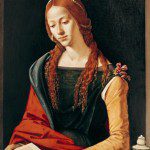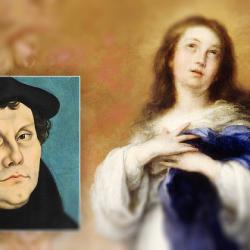. . . According to Popes and Catholic Scholars

Today, the liturgy reminds us of this consoling truth of faith, while it sings the praises of she who has been crowned with incomparable glory. We read today in the verse from Apocalypse proposed by the Church for our meditation: “And a great portent appeared in heaven, a woman clothed with the sun, with the moon under her feet, and on her head a crown of twelve stars” (12: 1). In this woman, resplendent with light, the Fathers of the Church have recognized Mary. In her triumph the Christian people, pilgrims in history, catch a glimpse of the fulfilment of its longing and a certain sign of its hope. (Angelus for the Solemnity of the Assumption of the Blessed Virgin Mary, 15 August 2006)
Having thus considered the various historical forms of the dragon, let us now look at the other image: the woman clothed with the sun, with the moon under her feet, surrounded by 12 stars. This is also a multidimensional image.
Without any doubt, a first meaning is that it is Our Lady, Mary, clothed with the sun, that is, with God, totally; Mary who lives totally in God, surrounded and penetrated by God’s light. Surrounded by the 12 stars, that is, by the 12 tribes of Israel, by the whole People of God, by the whole Communion of Saints; and at her feet, the moon, the image of death and mortality.
Mary has left death behind her; she is totally clothed in life, she is taken up body and soul into God’s glory and thus, placed in glory after overcoming death, she says to us: Take heart, it is love that wins in the end!
The message of my life was: I am the handmaid of God, my life has been a gift of myself to God and my neighbour. And this life of service now arrives in real life. May you too have trust and have the courage to live like this, countering all the threats of the dragon.
This is the first meaning of the woman whom Mary succeeded in being. The “woman clothed with the sun” is the great sign of the victory of love, of the victory of goodness, of the victory of God; a great sign of consolation.
Let us now look at this “woman clothed with the sun” (Rev 12:1) as she is described for us in Scripture. The Most Holy Virgin Mary, the glorious woman of the Apocalypse, wears on her head a crown of twelve stars which represent the twelve tribes of Israel, the entire people of God, the whole communion of saints, while at her feet is the moon, image of death and mortality. Mary left death behind her; she is entirely re-clothed with life, the life of her Son, the risen Christ. She is thus the sign of the victory of love, of good and of God, giving our world the hope that it needs. This evening, let us turn our gaze towards Mary, so glorious and so human, allowing her to lead us towards God who is the victor. (Homily at the Torchlight Procession at Lourdes, on the 150th Anniversary of the Apparitions, 13 September 2008)
Pope St. John Paul II
The figure of this Church is the woman whom the seer of Patmos contemplated and described in the text of the Apocalypse, which we have just heard in the second reading. In this woman crowned with twelve stars, popular piety throughout the ages has also seen Mary, the Mother of Jesus. Moreover, as St Ambrose recalled and as Lumen Gentium declares, Mary is herself a figure of the Church. Yes, beloved brothers and sons, Mary—the Mother of God—is a model for the Church and a mother for the redeemed. (Homily at Aparecida, Brazil, 4 July 1980)
From Mary, who represents the singular “fulfillment” of the biblical “woman” of the Proto-evangelium (cf. Gen 3:15) and of the Book of Revelation (12:1), let us seek also a proper relationship with women and the attitude toward them shown by Jesus of Nazareth himself. (Letter to Priests For Holy Thursday 1988, 25 March 1988; section 5)
“And a great portent appeared in heaven, a woman clothed with the sun, with the moon under her feet, and on her head a crown of twelve stars” (Rv 12:1).
These words of Revelation turn my thoughts to the 80th anniversary of the first apparition of the Virgin Mary to the three young shepherds in Cova da Iria. The message which the Blessed Virgin addressed to humanity on that occasion still resounds with all its prophetic force, inviting everyone to pray insistently, and to commit himself generously to making reparation for his own sins and those of the whole world. (Letter to the Bishop of Fatima, 12 May 1997)
Mary, glorified in her body, appears today as the star of hope for the Church and for humanity on its way towards the third Christian millennium. Her sublime exaltation does not distance her from her people or from the world’s problems, on the contrary, it enables her to watch effectively over human affairs with that attentive concern with which she obtained the first miracle from Jesus at the wedding in Cana.
Mary, taken up into heaven, show yourself to everyone as Mother of hope! Show yourself to everyone as Queen of the civilization of love! (Homily on the Solemnity of the Assumption of the Blessed Virgin Mary, 15 August 1998)
It was not by accident that Saint Gaspar del Bufalo established your Congregation on the Solemnity of the Assumption of Our Lady. For he saw in the glory of the Virgin the wondrous fruit of the sacrifice of her Son on the Cross. Christ’s Redemption marvellously restores humanity to the splendour which was the Creator’s intention from the beginning; and that splendour must be the goal of every plan and project of the Missionaries of the Precious Blood. That is why you must look always to the Woman “clothed with the sun, the moon beneath her feet, and on her head a crown of twelve stars” (Rev 12:1). Entrusting you to the loving care of Mary and to the intercession of your Founder, I gladly impart my Apostolic Blessing to the entire Congregation as a pledge of endless mercy in him “who has freed us from our sins by his blood” (Rev 1:5). (Address to the Missionaries of the Precious Blood, 14 September 2001)
“And a great portent appeared in heaven, a woman clothed with the sun, with the moon under her feet, and on her head a crown of twelve stars” (Rv 12: 1-2). St John’s vision shows us that Mary, glorified in Heaven, a Queen with a crown of stars, continues to be the Mother of all men and women, sons and daughters of God and brothers and sisters of Jesus Christ, until the end of the centuries. In the light of divine glory, she contemplates her children, each and every one, in every moment of their lives. (Letter for the Centenary of the Coronation of Nossa Senhora Aparecida, 17 July 2004)
This year the Pope joins you in this act of devotion and love for the Most Holy Virgin, the glorious woman of the Book of Revelation, crowned with twelve stars (cf. Rev 12,1). (Introduction to the Torchlight Procession at Lourdes on the 150th Anniversary of the Promulgation of the Dogma of the Immaculate Conception, 14 August 2004)
***
24. Leaving aside charity towards God, who can contemplate the Immaculate Virgin without feeling moved to fulfill that precept which Christ called peculiarly His own, namely that of loving one another as He loved us? “A great sign,” thus the Apostle St. John describes a vision divinely sent him, appears in the heavens: “A woman clothed with the sun, and with the moon under her feet and a crown of twelve stars upon her head” (Apoc. xii., 1). Everyone knows that this woman signified the Virgin Mary, the stainless one who brought forth our Head. The Apostle continues: “And, being with child, she cried travailing in birth, and was in pain to be delivered” (Apoc. xii., 2). John therefore saw the Most Holy Mother of God already in eternal happiness, yet travailing in a mysterious childbirth. What birth was it? Surely it was the birth of us who, still in exile, are yet to be generated to the perfect charity of God, and to eternal happiness. And the birth pains show the love and desire with which the Virgin from heaven above watches over us, and strives with unwearying prayer to bring about the fulfillment of the number of the elect.
(Encyclical Ad Diem Illum Laetissimum / On the Immaculate Conception, 2 February 1904)
The Woman in Revelation 12
28 In highly symbolic language, full of scriptural imagery, the seer of Revelation describes the vision of a sign in heaven involving a woman, a dragon, and the woman’s child. The narrative of Revelation 12 serves to assure the reader of the ultimate victory of God’s faithful ones in times of persecution and eschatological struggle. In the course of history, the symbol of the woman has led to a variety of interpretations. Most scholars accept that the primary meaning of the woman is corporate: the people of God, whether Israel, the Church of Christ, or both. Moreover, the narrative style of the author suggests that the ‘full picture’ of the woman is attained only at the end of the book when the Church of Christ becomes the triumphant New Jerusalem (Revelation 21:1-3). The actual troubles of the author’s community are placed in the frame of history as a whole, which is the scene of the ongoing struggle between the faithful and their enemies, between good and evil, between God and Satan. The imagery of the offspring reminds us of the struggle in Genesis 3:15 between the serpent and the woman, between the serpent’s seed and the woman’s seed.[4]
29 Given this primary ecclesial interpretation of Revelation 12, is it still possible to find in it a secondary reference to Mary? The text does not explicitly identify the woman with Mary. It refers to the woman as the mother of the “male child who is to rule all the nations with a rod of iron”, a citation from Psalm 2 elsewhere in the New Testament applied to the Messiah as well as to the faithful people of God (cf. Hebrews 1:5, 5:5, Acts 13:33 with Revelation 2:27). In view of this, some Patristic writers came to think of the mother of Jesus when reading this chapter.[5] Given the place of the book of Revelation within the canon of Scripture, in which the different biblical images intertwine, the possibility arose of a more explicit interpretation, both individual and corporate, of Revelation 12, illuminating the place of Mary and the Church in the eschatological victory of the Messiah.
[4] The Hebrew text of Genesis 3:15 speaks about enmity between the serpent and the woman, and between the offspring of both. The personal pronoun (hu’) in the words addressed to the serpent, “He will strike at your head,” is masculine. In the Greek translation used by the early Church (LXX), however, the personal pronoun autos (he) cannot refer to the offspring (neuter: to sperma), but must refer to a masculine individual who could then be the Messiah, born of a woman. The Vulgate (mis)translates the clause as ipsa conteret caput tuum (“she will strike at your head”). This feminine pronoun supported a reading of this passage as referring to Mary which has become traditional in the Latin Church. The Neo-Vulgate (1986), however, returns to the neuter ipsum, which refers to semen illius: “Inimicitias ponam inter te et mulierem et semen tuum et semen illius; ipsum conteret caput tuum, et tu conteres calcaneum eius.”
[5] Cf. Epiphanius of Salamis (†402), Panarion 78.11; Quodvultdeus (†454) Sermones de Symbolo III, I.4-6; Oecumenius (†c.550) Commentarius in Apocalypsin 6. (Mary: Grace and Hope in Christ: [2 February 2004], Anglican – Roman Catholic International Commission / the twelve Catholic participants included four bishops and five professors of theology; not an official Catholic document, but illuminating nonetheless)
What I would maintain is this, that the Holy Apostle would not have spoken of the Church under this particular image, unless there had existed a blessed Virgin Mary, who was exalted on high and the object of veneration to all the faithful. No one doubts that the “man-child” spoken of is an allusion to our Lord; why then is not “the Woman” an allusion to his mother? (“Letter to Pusey,” in Difficulties of Anglicans, Vol. 2, 1875)
***
Who is this Woman? Clearly, the Mother of the Messias (2, 5) but also of a vast posterity (17) . . . comparable with the ‘Jerusalem on high, the Mother of us all’ (Gal 4:26): Jerusalem, whether terrestrial or ideal, especially as representing the whole people of God, the Bride of God . . . The mass of tradition sees in the Woman both the synagogue and the Church [provides several patristic examples] . . . This does not exclude John’s having seen our Lady in this Woman — how could he not? Having spent so long in her company, he could not have written of the Mother of the Messias without being conscious of her, . . . And the moment he thinks of the ‘primeval serpent’ he must have remembered Eve; so the Woman becomes the Second Eve, and we have the series — the ‘Mother of the Messias’; the Universal Eve: Jerusalem and the People: the Church and Mary. The Immediate appearance of Mary as the Second Eve in patristic literature must surely be due in part to this passage. (A Catholic Commentary on Holy Scripture, edited by Dom Bernard Orchard, London: Thomas Nelson and Sons Ltd, 1953, 1202; commentary on 12:1-17)
***
The mysterious figure of the woman has been interpreted ever since the time of the Fathers of the Church as referring to the ancient people of Israel, or the Church of Jesus Christ, or the Blessed Virgin. The text supports all of these interpretations but in none do all the details fit . . .
The passage can also refer to the Virgin Mary because it was she who truly and historically gave birth to the Messiah, Jesus Christ our Lord . . .
At the same time the woman can be interpreted as standing for the people of God, the Church, whom the figure of Mary represents. (by the Theology Staff of the University of Navarre, Scepter Publishers, revised edition of 2005, 80-81)
I have taught very similarly for years, myself (mere lowly lay apologist that I am). For example, in my book, A Biblical Defense of Catholicism (2003; completed in 1996), I wrote (p. 200):
This passage has traditionally had a double interpretation, which is not unusual in Scripture. The primary application is to the Church, or the people of God. But a secondary reference can legitimately be made to the Blessed Virgin Mary, according to the literal meaning of 12:5, in which she bears the Messiah, Jesus (see Ps. 2:9). As such, the passage echoes the Mary/Eve symbolism of John 19:26-27.
Furthermore, the war with the dragon (identified as Satan in 12:9) recalls the Protoevangelion of Genesis 3:15 (“her seed” / “her offspring” battle the devil), and supports the notion of the spiritual motherhood of Mary. The symbolism of Mary as the Church and the New Eve was already prevalent in the early centuries of the Church. The “woman” here gives birth “in anguish” (12:2), which hearkens back to Genesis 3:16, and is perhaps an anticipation of Calvary.
***
Meta Description: Is the Blessed Virgin Mary the woman of Revelation 12, crowned with 12 stars? Popes & Catholic scholars affirm that she is.
Meta Keywords: Blessed Virgin Mary, Catholic Mariology, Immaculate Conception, impeccability of Mary, Marian doctrines, Revelation 12, Woman of Revelation 12, Mariology, Mary mother of Jesus, Mother of God, sinlessness of Mary, Theotokos, Virgin Mary, Assumption of Mary, Queen of Heaven

















